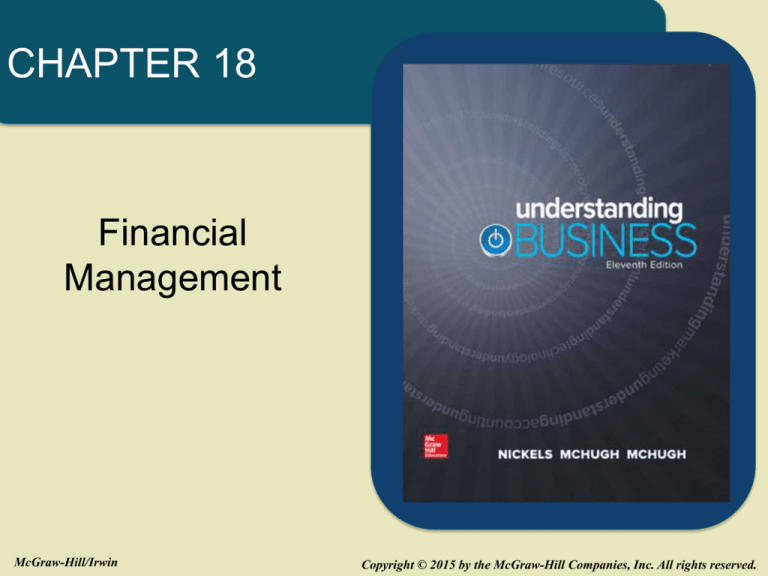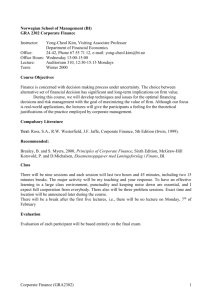
CHAPTER 18
Financial
Management
McGraw-Hill/Irwin
Copyright © 2015 by the McGraw-Hill Companies, Inc. All rights reserved.
LEARNING OBJECTIVES
1. Explain the role and responsibilities of financial
managers.
2. Outline the financial planning process, and explain
the three key budgets in the financial plan.
3. Explain why firms need operating funds.
4. Identify and describe different sources of short-term
financing.
5. Identify and describe different sources of long-term
financing.
18-2
SABRINA SIMMONS
Gap
• Simmons earned her
bachelor’s in finance at UCBerkeley and her MBA at
UCLA.
• Joined Gap as treasurer in
2001, balanced the books, and
eliminated the reliance on risky
investments.
• Encourages Gap to not be
afraid to create new brands,
even after failure.
18-3
NAME that COMPANY
This company spends over $6 billion a year on
research to develop new products even though it
may take as long as ten years before the
products are approved and introduced to the
market. Since long-term funding is very critical in
our business, high-level managers are very
involved in the finance decisions.
Name that company!
18-4
WHAT’S FINANCE?
LO 18-1
• Finance -- The function in a business that acquires
funds for a firm and manages them within the firm.
• Finance activities include:
- Preparing budgets
- Creating cash flow analyses
- Planning for expenditures
18-5
FINANCIAL MANAGEMENT
LO 18-1
• Financial Management -The job of managing a firm’s
resources to meet its goals and
objectives.
18-6
FINANCIAL MANAGERS
LO 18-1
• Financial Managers -- Examine financial data and
recommend strategies for improving financial
performance.
• Financial managers are
responsible for:
- Paying company bills
- Collecting payments
- Staying abreast of market
changes
- Assuring accounting
accuracy
18-7
WHO’S WHO in FINANCE
LO 18-1
• CFO -- Chief Financial Officer
• CFP -- Certified Financial
Planner
• CFA -- Chartered Financial
Analyst
• Comptroller -- Chief
Accounting Officer
18-8
FOUR SIGNS YOU NEED a CFO
LO 18-1
1. You do not have information on key items like
cash flow, working capital, or forecasts.
2. No one is carefully watching and analyzing your
expenses.
3. You are not aware of regulatory changes that
could affect your business.
4. You are unable to generate financial reports.
Source: Karen Stern, St. Louis Small Business Monthly, January 2014.
18-9
WHAT FINANCIAL
MANAGERS DO
LO 18-1
18-10
WHAT WORRIES FINANCIAL
MANAGERS
LO 18-1
• Consumer demand for their
firm’s products
• Credit markets and interest
rates
• Financial regulations from the
government
• Volatility of the dollar
• Foreign competition
• Environmental regulations
Source: CFO Magazine, www.cfo.com, accessed November 2014.
18-11
WHY DO FIRMS
FAIL FINANCIALLY?
LO 18-1
1) Undercapitalization
2) Poor control over cash
flow
3) Inadequate expense
control
18-12
TOP FINANCIAL CONCERNS
of COMPANY CFOs - MACRO
LO 18-1
• Consumer demand
• Federal-government policies
• Price pressure from
competitors
• Credit markets/interest rates
• Global financial instability
Source: CFO Magazine, www.cfo.com, accessed November 2014.
18-13
TOP FINANCIAL CONCERNS
of COMPANY CFOs - MICRO
LO 18-1
• Ability to maintain margins
• Ability to forecast results
• Maintaining
morale/productivity
• Cost of healthcare
• Working-capital
management
Source: CFO Magazine, www.cfo.com, accessed November 2014.
18-14
FINANCIAL PLANNING
LO 18-2
• Financial planning involves analyzing short-term
and long-term money flows to and from the
company.
• Three key steps of financial planning:
1. Forecasting the firm’s short-term and long-term financial
needs.
2. Developing budgets to meet those needs.
3. Establishing financial controls to see if the company is
achieving its goals.
18-15
FINANCIAL FORECASTING
LO 18-2
• Short-Term Forecast -- Predicts revenues, costs
and expenses for a period of one year or less.
• Cash-Flow Forecast -- Predicts the cash inflows
and outflows in future periods, usually months or
quarters.
• Long-Term Forecast -- Predicts revenues, costs,
and expenses for a period longer than one year and
sometimes as long as five or ten years.
18-16
BUDGETING
LO 18-2
• Budget -- Sets forth management’s expectations for
revenues and allocates the use of specific resources
throughout the firm.
• Budgets depend heavily on the balance sheet,
income statement, statement of cash flows and
short-term and long-term financial forecasts.
• The budget is the guide for financial operations
and expected financial needs.
18-17
TYPES of BUDGETS
LO 18-2
• Capital Budget -- Highlights a firm’s spending
plans for major asset purchases that often require
large sums of money.
• Cash Budget -- Estimates cash inflows and outflows
during a particular period like a month or quarter.
• Operating (Master) Budget -- Ties together all the
firm’s other budgets and summarizes its proposed
financial activities.
18-18
FINANCIAL PLANNING
LO 18-2
18-19
ESTABLISHING
FINANCIAL CONTROL
LO 18-2
• Financial Control -- A process
in which a firm periodically
compares its actual revenues,
costs and expenses with its
budget.
18-20
FACTORS USED in ASSESSING
FINANCIAL CONTROL
LO 18-2
• Is the firm meeting its short-term financial
commitments?
• Is the firm producing adequate operating profits
on its assets?
• How is the firm financing its assets?
• Are the firms owners receiving an acceptable
return on their investment?
18-21
TEST PREP
• Name three finance functions important to the
firm’s overall operations and performance.
• What three primary financial problems cause firms
to fail?
• How do short-term and long-term financial
forecasts differ?
• What’s the purpose of preparing budgets? Can
you identify three different types of budgets?
18-22
KEY NEEDS for OPERATIONAL
FUNDS in a FIRM
LO 18-3
• Managing day-by-day
needs of the business
• Controlling credit
operations
• Acquiring needed
inventory
• Making capital
expenditures
18-23
HOW SMALL BUSINESSES
CAN IMPROVE CASH FLOW
LO 18-3
• Be more aggressive in collecting
accounts receivable.
• Offer customers discounts for
paying early.
• Take advantage of special
payment terms from vendors.
• Raise prices.
• Use credit cards discriminately.
Source: American Express Small Business Monitor.
18-24
GOOD FINANCE
or BAD MEDICINE?
• You are a new hospital administrator at a small
hospital that, like many others, is experiencing
financial problems.
• You suggest discontinuing the hospital’s large
stockpile of drugs and shift to ordering them just
when they are needed.
• Some like the idea, but the doctors claim you are
sacrificing patients’ well-being for cash. What do
you do? What could be the result of your
decision?
18-25
USING ALTERNATIVE
SOURCES of FUNDS
LO 18-3
• Debt Financing -- The funds
raised through various forms of
borrowing that must be repaid.
• Equity Financing -- The
funds raised from within the firm
from operations or through the
sale of ownership in the firm
(such as stock).
18-26
SHORT and LONG-TERM
FINANCING
LO 18-3
• Short-Term Financing -Funds needed for a year or less.
• Long-Term Financing -Funds needed for more than a
year.
18-27
WHY FIRMS NEED FINANCING
LO 18-3
18-28
TEST PREP
• Money has time value. What does this mean?
• Why is accounts receivable a financial concern of
the firm?
• What’s the primary reason an organization
spends a good deal of its available funds on
inventory and capital expenditures?
• What’s the difference between debt and equity
financing?
18-29
TYPES of
SHORT-TERM FINANCING
LO 18-4
• Trade Credit -- The practice of buying goods or
services now and paying for them later.
• Businesses often get terms such as 2/10 net 30
when receiving trade credit.
• Promissory Note -- A written contract agreeing to
pay a supplier a specific sum of money at a definite
time.
18-30
TYPES of
SHORT-TERM FINANCING
LO 18-4
• Many small firms obtain short-term financing from
friends and family.
• If asking for help from family or friends, it’s
important both parties:
1) Agree to specific loan terms
2) Put the agreement in writing
3) Arrange for repayment the same way they would for
a bank loan
18-31
DIFFICULTY of OBTAINING
SHORT-TERM FINANCING
LO 18-4
• Banks generally
prefer to lend shortterm money to larger,
more established
businesses.
• The recent financial crisis has made it difficult for
even promising and well-organized businesses
to get loans.
18-32
THREADING the FINANCIAL NEEDLE
• Started thredUP with classmates
while studying for his MBA at
Harvard.
• Launched the company in 2009
as a way to buy and sell adult
clothing.
• Transitioned into children’s
clothes.
• The company continues to attract
huge investments to further
improve the site.
18-33
DIFFERENT FORMS of
SHORT-TERM LOANS
LO 18-4
• Commercial banks offer short-term loans like:
- Secured Loans -- Backed by collateral.
- Unsecured Loans -- Don’t require collateral
from the borrower.
- Line of Credit -- A given amount of money the
bank will provide so long as the funds are
available.
- Revolving Credit Agreement -- A line of
credit that’s guaranteed but comes with a fee.
18-34
FACTORING
LO 18-4
• Factoring -- The process
of selling accounts
receivable for cash.
• Factors charge more than
banks, but many small
businesses don’t qualify
for loans.
18-35
COMMERCIAL PAPER
LO 18-4
• Commercial Paper -- Unsecured promissory notes
in amounts of $100,000+ that come due in 270 days
or less.
• Since commercial paper is unsecured, only
financially stable firms are able to sell it.
18-36
LO 18-4
CREDIT CARDS
• Rates for small businesses
grew almost 30% after The
Credit Card Responsibility
Accountability and
Disclosure Act was passed.
• Credit cards are convenient
but costly for a small
business.
Photo Creditf: Robert Scoble
18-37
WAYS to RAISE
START-UP CAPITAL
LO 18-4
• Seek out a microloan from a microlender
• Use asset-based lending or factoring
• Turn to the web and seek
out peer-to-peer lending
• Research local banks
• Sweet-talk vendors you
want to do business with
Sources: St. Louis Small Business Monthly, January 2014 and Entrepreneur, www.entrepreneur.com, accessed November 2014.
18-38
HOW COMPANIES FAIL to
RAISE CAPITAL
LO 18-4
1. There is no formalized business plan to show
need.
2. The company does not know how much to
request from a lender.
3. Poor credit.
4. Management is unrealistic about growth.
Source: St. Louis Small Business Monthly, January 2014.
18-39
TEST PREP
• What does an invoice containing the terms 2/10,
net 30 mean?
• What is the difference between trade credit and a
line of credit?
• What is the key difference between a secured and
an unsecured loan?
• What is factoring? What are some of the
considerations factors consider in establishing
their discount rate?
18-40
SETTING LONG-TERM
FINANCING OBJECTIVES
LO 18-5
• Three questions of financial managers in setting longterm financing objectives:
1. What are the organization’s long-term goals and
objectives?
2. What funds do we need to achieve the firm’s long-term
goals and objectives?
3. What sources of long-term funding (capital) are
available, and which will best fit our needs?
18-41
The FIVE “C”s of CREDIT
LO 18-5
1. The character of the borrow.
2. The borrower’s capacity to repay the loan.
3. The capital being invested in the business by
the borrower.
4. The conditions of the economy and the firm’s
industry.
5. The collateral the borrower has available to
secure the loan.
18-42
ARE THEY HEROS or HUSTLERS?
• Rich nations place their excess incomes into
sovereign wealth funds (SWFs).
• SWFs are hailed as heroes when billions are
invested in distressed companies. However, some
grow concerned with the presence of foreign
governments.
• Much of that concern seems to be unfounded
because of investigations by the U.S.
government.
18-43
USING LONG-TERM
DEBT FINANCING
LO 18-5
• Long-term financing loans generally come due
within 3 -7 years but may extend to 15 or 20
years.
• Term-Loan Agreement -- A promissory note that
requires the borrower to repay the loan with interest in
specified monthly or annual installments.
• A major advantage of debt financing is the interest
the firm pays is tax deductible.
18-44
USING DEBT FINANCING
by ISSUING BONDS
LO 18-5
• Indenture Terms -- The terms
of agreement in a bond issue.
• Secured Bond -- A bond
issued with some form of
collateral (i.e. real estate).
• Unsecured (Debenture)
Bond -- A bond backed only by
the reputation of the issuing
company.
18-45
SECURING EQUITY FINANCING
LO 18-5
• A company can secure equity financing by:
- Selling shares of stock in the
company.
- Earning profits and using the
retained earnings as
reinvestments in the firm.
- Attracting Venture Capital -Money that is invested in new or
emerging companies that some
investors believe have great
profit potential.
18-46
WANT to ATTRACT a
VENTURE CAPITALIST?
LO 18-5
1. Can the company
grow?
2. Will we get our money
back and more?
3. Will it be worth our
money and effort?
Source: Entrepreneur, www.entrepreneur.com, accessed November 2014.
18-47
DIFFERENCES BETWEEN
DEBT and EQUITY FINANCING
LO 18-5
18-48
USING LEVERAGE for
FUNDING NEEDS
LO 18-5
• Leverage -- Raising funds through borrowing to
increase the firm’s rate of return.
• Cost of Capital -- The rate of return a company
must earn in order to meet the demands of its lenders
and expectations of equity holders.
18-49
USING DEBT vs. EQUITY FINANCING
LO 18-5
18-50
LESSONS LEARNED from the
RECENT FINANCIAL CRISIS
LO 18-5
• The recent financial crisis was the worst fall since
the Great Depression.
• Led to the passage of
sweeping financial
reform.
• Government is
increasing involvement
and intervention.
18-51
TEST PREP
• What are the two major forms of debt financing
available to a firm?
• How does debt financing differ from equity
financing?
• What are the three major forms of equity financing
available to a firm?
• What is leverage, and why do firms choose to use
it?
18-52








